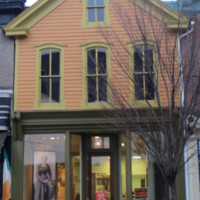
Harriet Tubman Museum
The Harriet Tubman Museum is a small museum located in Cambridge, Maryland, a few miles from where Harriet Tubman was born. The museum originated as a community organization which was planning a single three-day event honouring Harriet Tubman in 1983. Over the years, the Harriet Tubman Organisation has adjusted its goals; today its mission 'is to develop programs and services for children and families and to preserve the history and memory of Harriet Tubman by offering the general public an interpretive history of her achievements.'
The museum's permanent exhibition is a combination of interpretive text and artefacts, many recovered from nearby plantations. The artefacts on display represent the objects that the enslaved would have used in their daily lives, as well as more brutal symbols of slavery like shackles. The museum, which accepts admission donations, is usually open Tuesday - Saturday. Through the museum, visitors can also organise trips to the actual property where Tubman was born and worked. The museum hosts school groups as well as a range of special events throughout the year.
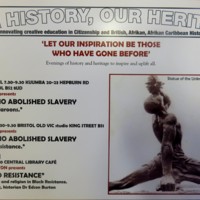
Our History, Our Heritage
Our History, Our Heritage was a black-led Bristol group promoting historical awareness of the contributions of African, African-Caribbean and British peoples in past and present struggles, and in Bristol in particular. Their series of talks and educational initiatives sought to encourage 'creative education in Citizenship and British, Afrikan, Afrikan Caribbean History', taking inspiration from 'those who have gone before'.
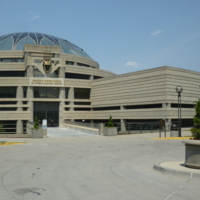
Charles H. Wright Museum of African American History
The museum was established by Dr. Charles Wright, an obstetrician and gynaecologist who envisioned an institution to preserve Black history after visiting a memorial to Danish World War II heroes in Denmark. It opened in 1965 as Detroit’s first international Afro-American museum. After expansions in 1978 and 1992, the museum was finally named the Charles H. Wright museum after its founder in 1998. It has since received monetary support from individuals, foundations, corporations, and government sources. The mission statement of the museum is to open minds and change lives through the exploration and celebration of African American history and culture.
Current exhibitions on display in the museum include a large 22,000 square-foot exhibition that examines Ancient and Early Modern African history and the experiences of the enslaved during the Middle Passage, alongside the experiences of those who resisted the horrors of bondage and self-emancipation. Throughout this exhibition, entitled ‘And Still We Rise: Our Journey Through African American History and Culture,’ there is a clear emphasis on the efforts of the everyday African American people who built families, businesses, educational institutions, and civic organisations in Detroit, past and present. The museum also offers exhibitions that look at the contributions of African Americans in science and technology, as well as showcasing examples of stained glass art by Samuel A. Hodge.
The museum has a busy events programme that includes community health and fitness programs, as well as lectures and education sessions for both children and adults. There are group tours for all ages, as well as led workshops for pre-school children. All of these workshops aim to highlight the lessons portrayed in the ‘And We Rise’ exhibition, prompting reflection and discussion from visitors.
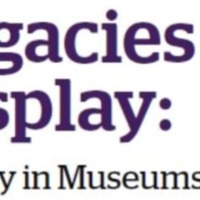
America's Black Holocaust Museum
The museum was founded in 1984 by Dr James Cameron, a self-taught historian and public speaker. The only known survivor of a lynching, Dr Cameron used his survival experience to provide visitors with a unique view of ‘living history’. Alongside this, he expanded the museum’s exhibits and employed staff, attracting local, national and international visitors. Unfortunately, the site closed following Dr Cameron’s passing in 2006 and the economic downturn of 2008. Since 2012 America’s Black Holocaust Museum has existed as a virtual museum. It seeks to educate the public of injustices suffered by people of African-American heritage, while providing visitors with an opportunity to rethink their assumptions about race and racism. It offers a range of online exhibitions, including one about the history of the museum, and another on the perpetuation of slavery through three centuries.
There are nine exhibitions available to be accessed within the virtual museum, seven of which are a chronological study of the history of Africans in America. All of them feature the museum’s four key themes: remembrance, resistance, redemption and reconciliation. Beginning with a view of life in Africa prior to enslavement, they end with an exhibition entitled ‘Now- Free at Last?’ which considers the experiences of African Americans from the 1980s up to the present day. In addition to the chronological displays, there are three special exhibitions, two of which are concerned with the victims of lynching. Within the website there are photographs, and images of objects, alongside suggestions of further reading material. There is also a section of relevant and important news articles. The virtual museum is a member of the international Coalition of Sites of Conscience, and the Association of African American Museums. The museum runs a programme of events and speakers, and is due to re-open in a physical building in Milwaukee during the Autumn of 2018.
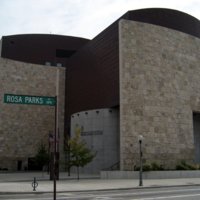
National Underground Railroad Freedom Centre
The National Underground Railroad Freedom Centre opened in August 2004 and has since strived to tell the stories of those who have fought for freedom from the Underground Railway to the present day in the hope of challenging people’s ideas about inclusivity and freedom. The museum also aims to encourage and inspire people to promote and work towards freedom. Its position next to the Ohio River is a poignant reminder of its purpose as this river separated the southern slave states from the free states of the North. The National Underground Freedom Centre examines America’s heritage alongside discussions of contemporary slavery and human trafficking. It also forms part of a group of 'Museums of Conscience' alongside three others across the United States, including the United States Holocaust Memorial Museum. The National Underground Railroad Freedom Centre reveals stories about freedom’s heroes: the men, women and children who challenge inequities to pursue greater freedom for their brothers and sisters. Through a series of rolling ‘special exhibitions’ and its vast collections displayed in several permanent exhibition spaces, the museum highlights the long history of enslavement in America, and its continuing legacy in the modern world.
The centre's most significant artifact is an original slave pen (or prison) originally built in 1830, and thought to be the only surviving example in the world. Visitors can walk through the pen and see some of the names of the people who were once held there. Alongside the pen, which is housed in its own exhibition space on the museum's second floor, there is a permanent exhibition, 'From Slavery to Freedom.' This exhibition covers three hundred years of slavery from its introduction to the Americas to its abolition. 'From Slavery to Freedom' is funded by the Oprah Winfrey Foundation and features a range of collections, including artefacts, archaeological specimens and paintings.
The centre also houses the 'world's first museum-quality, permanent exhibition on the subjects of modern-day slavery and human trafficking'; 'Invisible: Slavery Today' uses the experiences of five individuals who have been caught up in different forms of contemporary slavery and exploitation to highlight the issue in the modern world, as well as including examples of modern antislavery work around the world.
The centre also contains examples of interactive exhibits, with films, hands-on activities and live gallery talks, aimed at providing their visitors with a multi-sensory experience.
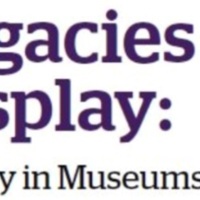
Hanover Museum
The Hanover Museum dates back to the eighteenth century, and is housed in a former slave prison. It was redeveloped in 2011 and now stands as an important symbol of resistance to the people of Jamaica. Situated in the small town of Lucea, between Montego Bay and Negril, the museum sits within a wider landscape of Georgian colonial architecture. Other buildings of historical significance include the nearby church and Fort Charlotte.
The museum houses a varied collection charting the development of the town from the period of plantation slavery to Jamaican independence from British rule. There are paintings, pottery and other artefacts that showcase what life was like for the enslaved. There are also instruments, including stocks, whips and shackles, that highlight the brutal nature of enslavement. In addition, the museum houses a significant collection of archival material, including plantation records and accounts, as well as an early, hand-drawn map of the harbour and surrounding area by Captain William Bligh.
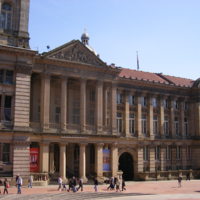
Birmingham Museum and Art Gallery
Birmingham Museum and Art Gallery has over forty display galleries that explore the development of Birmingham as a city, through its diverse communities. Since opening in 1885, the museum has built a vast collection of social history, art, archaeology and ethnographic items. It is one of nine sites managed by Birmingham Museums, the largest museums trust in the UK, whose vision for their service is, ‘to reflect Birmingham to the world, and the world to Birmingham.’ Housed within Birmingham's council buildings in the city's Chamberlain Square, the site welcomes around one million visitors a year.
Slavery and abolition feature as themed displays within the ‘Birmingham: Its People and Its History’ gallery, which dominates the third floor of the Victorian museum. Initially developed as part of the 2007 bicentennial commemoration activities, the displays highlight the contradictory nature of Birmingham’s relationship with the slave trade. Visitors are informed, through both interpretive text panels and collections artifacts on display, about the goods manufactured in Birmingham that were taken to Africa to trade in exchange for human beings. Simultaneously, the presence of antislavery activists in the city is explained, with digital interactives, portraits and abolitionist material culture all illustrating the role of Quakers and other prominent abolitionist figures, including Joseph Sturge and Olaudah Equiano.
The displays also alert visitors as to the existence of modern slavery by a panel headed with the words, ‘Around the world, people are still enslaved today.’ The visitors are then invited to leave their own comments as to how society can help to stop it in their community and around the world.
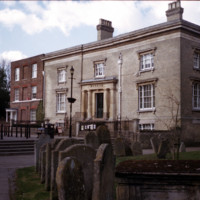
Wisbech and Fenland Museum
The Wisbech and Fenland Museum is one of the oldest, purpose-built museums in Britain. With its origins dating back to 1835, visitors are welcomed into a real ‘treasure house,' with collections housed in original nineteenth century cases. The museum is free to enter and focusses on local history, housing the vast and varied collection of the town’s literary and museum societies. Using these, the museum presents displays on a range of themes relating to key local industries, wildlife, archaeological finds and important people from the area.
One of these important people is Wisbech-born Thomas Clarkson, and it is through him that the theme of antislavery fills several of the largest cases in the main gallery. Using a combination of personal collections, archive material and objects linked to the wider slave trade (notably whips and a manacle), the museum follows Thomas Clarkson’s contribution to the abolition campaign, both in Britain and abroad. The museum also exhibits the narrative of Thomas’ brother John Clarkson who was instrumental in facilitating the movement of freed-slaves from Nova Scotia, Canada, to Sierra Leone.
This display was developed as a larger, standalone exhibition for the 2007 bicentenary entitled ‘A Giant with One Idea,’ but this was reduced following the end of the commemorations as funding was withdrawn.
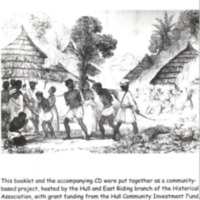
Songs of Slavery
The Songs of Slavery CD and booklet were produced by a community-based project, led by the Hull and East Riding branch of the Historical Association. The project was part of the Wilberforce 2007 initiative in Hull. Songs of Slavery recorded 19 songs relating to slavery, alongside six short narratives. Most of the songs date from the mid-19th century and were originally composed and sung by enslaved peoples. Some were based on religious beliefs, others also contained coded messages to aid escape and resistance. The Songs of Slavery tracks were sung or narrated by local choirs, singers and musicians, together with students from local schools and colleges.
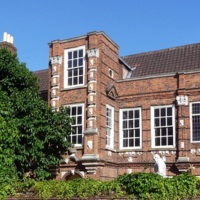
Wilberforce House Museum
Wilberforce House Museum is one of the world's oldest slavery museums. It opened in 1906 after the building, the house where leading abolitionist William Wilberforce was born, was bought by the Hull Corporation to preserve it for reasons of learning and of civic pride. Initially a local history museum, at the centre of Hull's historic High Street, the collections soon expanded through public donations and, unsurprisingly, these donations focussed heavily on items relating to Wilberforce. Today the museum and its collections are owned by Hull City Council and managed by Hull Culture and Leisure Limited. It forms part of Hull's 'Museums Quarter' alongside museums on transport, local social history and archaeology. In addition to the Wilberforce displays, the museum also features period room settings, silver, furniture and clocks, as well as a gallery exploring the history of the East Yorkshire Regiment.
The galleries at Wilberforce House Museum tell many different stories. An exploration of the history of the house welcomes visitors into the museum, followed by displays about William Wilberforce from his childhood, to his work and his family life. These galleries have examples of costume, books, domestic items and even the 1933 Madame Tussauds wax model of Wilberforce himself. Up the grand cantilever staircase, installed by the Wilberforce family in the 1760s, the displays continue. Here they look at the history of slavery and the origins of the British transatlantic slave trade. One gallery contains items that illustrate the richness of African culture prior to European involvement, dispelling the traditional myth that Africa was empty and uncivilised before the intervention of the Western world. Following that, the exhibition narrative goes on to look at the process of enslavement, the logistics of the trading system, the Middle Passage and slave auctions. Again, a wide range of collections are used to illustrate the informative panels. This is repeated in the displays about plantation life and resistance.
Of course no museum about William Wilberforce would be complete without an exhibition on antislavery and the abolition movement. This is extended with two galleries which look at the legacies of such a campaign in terms of modern slavery and human rights today. There are opportunities in these galleries for visitors to provide their comments and opinions, through several interactives, as well as engage with ideas as to how they can actively participate in today's campaign to end modern slavery.
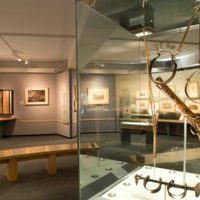
National Maritime Museum
The National Maritime Museum is the largest maritime museum in the world. It forms part of the Royal Museums Greenwich UNESCO World Heritage Site. The NMM houses ten galleries that all showcase Britain’s Maritime History. Its mission is 'to enrich people’s understanding of the sea, the exploration of space, and Britain's role in world history’. ‘The Atlantic Worlds Gallery,' launched in 2007 for the commemoration of the bicentenary, charts the interconnections between Britain, Africa and the Americas between 1600 and 1850. The gallery is about the movement of people, goods and ideas across and around the Atlantic Ocean from the 17th century to the 19th century. The connections created by these movements affected people across three continents, impacting on their cultures and communities and shaping the world we live in today. Four main themes are explored within the gallery, including exploration, war, enslavement and resistance. These displays benefited extensively from the museum's purchase of the Michael Graham-Stewart Slavery Collection in 2002. 'Atlantic Worlds' charts the triangular trade through African civilisations, enslavement and the Middle Passage, and the abolition movement. It recounts the stories of some of the people involved in the resistance movement and the campaign for the abolition of the transatlantic slave trade – including Toussaint l’Ouverture, Olaudah Equiano and Samuel Sharp whose acts of resistance and rebellion were crucial to the turning of European public opinion against the trade. Its narrative also goes beyond the achievement of legal abolition in Britain, to include discussions of the Royal Navy's involvement in suppressing the trade world wide.
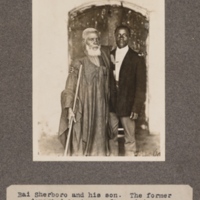
Bai Sherbo and his son. The former deported to Accra after rising in Sierra Leone
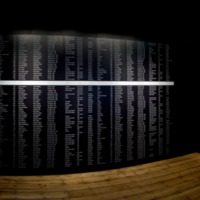
Museum of London Docklands
The Museum of London Docklands houses the Port and River collections of the Museum of London. The aim of these museums is to showcase the growth and development of London, from the Roman era through to the present day. In a period of expansion for the Museum of London, the Museum of London Docklands was opened in 2003 in a Grade I listed warehouse on West India Quay, the historic trading heart of London.
Due to its location in a warehouse which would very likely have stored sugar, and other slave-produced items, the history of the transatlantic slave trade and its impact on London fits well within this space. ‘London, Sugar and Slavery’ was originally produced in 2007 as part of the bicentenary commemorations but has since become a permanent part of the museum. The displays have a local focus, supported through a wide range of objects, and consider the impact of the slave trade on London historically and today.
On entering the gallery visitors are met with a list of ships that traded slaves from the West India Quay- placing them right there in the story. Next there are discussions of the economics of slavery, and indications of how the money made from it changed the city of London forever. The exhibition also includes discussions of resistance, and abolition- centring the movement on the mass movement in the wider population with a case entitled ‘Abolition on the Streets.’ To bring the display up to date there is a discussion of representations of black people in popular culture, with objects including children’s books, film memorabilia, toys and prints, in line with a further piece on racism in London.
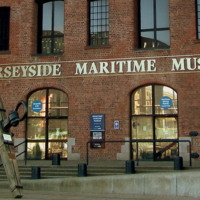
International Slavery Museum
The International Slavery Museum (ISM) is the first museum in the world to focus specifically on slavery, both historical and modern. Managed by National Musuems Liverpool, it opened to great acclaim in 2007 and has since welcomed over 3.5million visitors. Through its displays and wide-ranging events programme, the ISM aims to tackle ignorance and misunderstanding in today’s society by exploring the lasting impact of the transatlantic slave trade around the world. On entering the ISM, visitors immediately arrive in a space designed to provoke thoughts and discussion- the walls are etched with powerful quotations from historical figures and contemporary activists, many from the African diaspora. There is a display of West African culture, designed to showcase the breadth and depth of African civilisation before the devastation caused by the transatlantic slave trade, which includes examples of textiles, musical instruments and other ethnographic material. The display then goes on to look at the trade itself; the logistics, the processes and who benefitted on one hand, whilst also exploring the experience of the enslaved through multisensory interpretive techniques, including an emotive film of what the Middle Passage may have been like. All of these displays are supported by the rich, local archival collections, drawing on Liverpool’s own history as a prosperous, slave-trading port. Moving forward along a chronological timeline, the exhibition then covers abolition, significantly beginning with the acts of resistance from the enslaved themselves, through to organised abolition movements and then discussing the continued fight for freedom through the post-emancipation then civil rights era, right into the twenty-first century. The lasting legacies of the trade are thoroughly examined, from racism and the under-development of African countries, to the spread of African culture and diverse nature of Liverpool’s communities. A unique feature of the ISM is its ‘Campaign Zone’, opened in 2010, which houses temporary exhibitions just off the main gallery space. These are frequently run in conjunction with campaign organisations and usually focus on aspects of modern slavery, highlighting to visitors that it is very much still a live issue and not one that has been relegated to history. Recent exhibitions in this space have included 'Broken Lives' organised with the Daalit Freedom Network and 'Afro Supa Hero' with artist Jon Daniels.
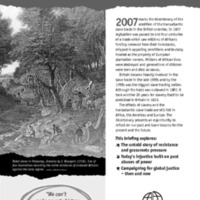
200 Years On: The legacies of enslavement and abolition
The World Development Movement seeks to increase awareness of political views in regards to world economic and social development. The organisation published a briefing in 2007 to mark the bicentenary, exploring the stories of grassroots pressure and the historic and modern campaigns for global justice. In collaboration with the University of Leeds, the World Development Movement also organised two public events looking to explore the lessons to be learned from the struggle to end the slave trade and examining contemporary campaigns in Africa and beyond for global social justice. Speakers included the Kenyan writer and academic Ngugi wa Thiong'o.
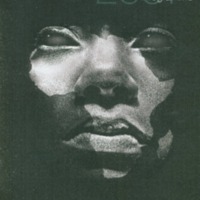
2007 Bicentenary for the Abolition of the Slave Trade Act at the National Maritime Museum
The National Maritime Museum marked the bicentenary with a range of initiatives and events including a new exhibition, a film season, poetry, music, debates, and new publications. A new permanent gallery opened at the museum in winter 2007 exploring Britain's Atlantic empire. A catalogue of slavery-related images, artefacts and documents from the collections of the museum, 'Representing Slavery', was published. The museum also devised a transatlantic slavery trail around Greenwich.
The National Maritime Museum hosted a number of events throughout 2007. The theme of the weekend 23-25 March was 'And still I rise', marked with a series of activities, performances and discussion. On August 23, International Day for the Remembrance of the Slave Trade and its Abolition, the ‘Freedom Festival: Contemporary Commemoration’ event saw a programme of creative events and performances exploring themes around the heritage of enslavement. The museum also offered a range of learning experiences based on its collections. For example, in November, a study session, 'Roots of Resistance: Abolition 1807' examined the roots of resistance and the abolition movement through talks by curators and contemporary artists. Activities for families were based on themes of freedom and carnival. 'The Big Conversation 2007' was a programme of debate and showcasing of diverse projects undertaken by students around the country, organised by the Understanding Slavery Initiative and the Department for Children, Schools and Families.
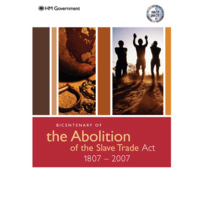
Bicentenary of the Abolition of the Slave Trade Act 1807-2007
The official publication from the British Government in response to the bicentenary included a message from Prime Minister Tony Blair. It set out the history of transatlantic slavery and resistance to it, and featured a calendar of upcoming events for 2007 relating to slavery and abolition. The publication also detailed contemporary efforts to end modern slavery. Later in 2007, 'The way forward: bicentenary of the abolition of the Slave Trade Act 1807-2007' reflected on some of the commemorative activity that had taken place in Bristol, Hull, Liverpool, London and Greater Manchester. With a foreword by the new Prime Minister, Gordon Brown, the theme of the publication was 'Reflecting on the past, looking to the future' and it linked efforts for the abolition of historical and contemporary slavery. The publication also looked to how to tackle inequality and poverty in the UK, Africa and the Caribbean.
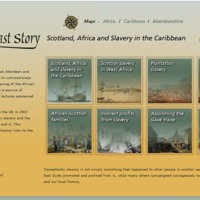
A North East Story: Scotland, Africa and Slavery in the Caribbean
This online exhibition and learning resource linking the history of transatlantic slavery to North East Scotland was organised by an Aberdeen and Aberdeenshire Bicentenary Committee, including representatives from Aberdeenshire Council, Aberdeen City Council, the University of Aberdeen, the Robert Gordon University and the African and African-Caribbean communities. It followed on from a service of commemoration and a series of public lectures sponsored by the Committee in 2007. The exhibition logo is inspired by the mythical Sankofa bird, a cultural symbol of the Akan-speaking peoples of Ghana in West Africa. Featured here are a number of resources available to download from the North East Story website.
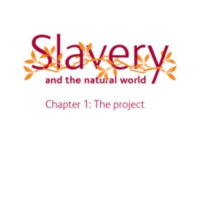
Slavery and the Natural World
In consultation with local community groups, in 2007 the Natural History Museum commissioned new research into its collections that link slavery and the natural world. The research uncovered experiences of enslaved people and the use of plants in their everyday life, as food, medicines and poisons. It also examined the complex relationships between enslaved people and naturalists exploring newly-colonised lands. The museum ran a series of public events, co-hosted by Race on the Agenda, which aimed to bring the historical, scientific and public viewpoints together. It created online educational resources on themes such as Commercial Plants, Everyday Life, Diet and Nutrition, and Resistance. The museum also developed cross-curricular ideas for school lessons in Science using the context of slavery, looking at foods across different cultures, for example.
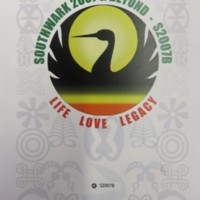
Southwark 2007 & Beyond (S2007B)
The Southwark 2007 & Beyond Steering Group was established to correct perceived misinformation about Britain's role in perpetuating slavery, and to promote education and dialogue on anti-slavery resistance and human rights. The Steering Committee was composed of representatives from Southwark's Afrikan, Afrikan Caribbean and Afro-descendant communities, and the year-long programme of events was funded by Southwark Council. August 2007 was a key month of the commemorative programme, focused on 23 August, the United Nations International Day for Remembrance of the Slave Trade and its Abolition, and the anniversary of the beginning of the Haitian Revolution. A 'Vigil of Remembrance, Resistance and Repairs' included speakers, performances and a libation ceremony. Other events included 'A Bicentennial Dialogue' featuring a keynote address by Dr Joy DeGruy-Leary. The publication 'Abeng Soundings: Abolitionist Landmarks of our Freedom March', co-authored by Esther Stanford of Rendezvous of Victory, provided an overview of the resistance efforts of African freedom fighters against slavery.